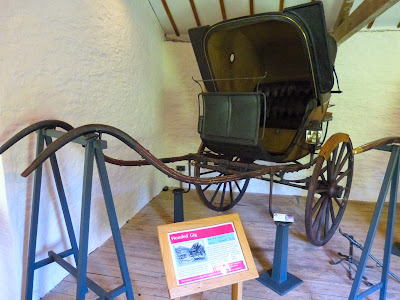 |
| The National Trust Carriage Museum, Arlington Court (2014) |
The National Trust Carriage Museum is housed in the stables of Arlington Court near Barnstaple in North Devon.
History
In 1966, the National Trust decided to start a collection of British carriages and display them in the stables of Arlington Court – one of the few stables of a National Trust property that had not already been converted into a restaurant or other building.
 |
| The stables, Arlington Court (2014) |
Some of the carriages were gifted to the Trust, such as eight carriages from the 7th Marquess of Bute, whereas others are on loan, mostly from other National Trust properties and museums.
The collection
The National Trust Carriage Collection includes a wide variety of carriages, mostly dating from the 1800s. I have highlighted a few of the earliest vehicles.
The Speaker’s State Coach
This recently restored golden coach dates from the late 17th century and was used by the Speaker of the House of Commons. It is on loan from the Houses of Parliament.
State coach and state chariots
 |
| State coach, Arlington Court (2014) |
These carriages date from the mid-1800s and because they were only used for state occasions, they are in very good condition.
The main difference between a state coach and a state chariot is the shape of the body. A coach can seat four people inside on two seats, one ahead of the doors and one behind the doors. A chariot, on the other hand, is only designed to seat two people and they both sit on the single seat behind the doors.
 |
| State chariot, Arlington Court (2014) |
Both state coaches and chariots would have been driven by a coachman in full livery with a decorative seat cloth covering the coachman’s seat known as a hammer cloth (shown under a protective covering in both photographs above).
Behind the carriage body is the footmen’s cushion – a padded perch on which two liveried footmen would stand.
Travelling chariots
 |
| Travelling chariot, Arlington Court (2014) |
A travelling chariot accommodated two people on a single seat behind the doors. It was used for long journeys, including making the Grand Tour.
It was postilion-driven which meant that the carriage was driven by one or more post-boys riding the horses instead of by a coachman on a box. However, a coachman’s seat could be added to adapt it for driving about town.
A selection of other carriages on display
Barouche
 |
| Barouche, Arlington Court (2014) |
 |
| Double Brougham, Arlington Court (2014) |
 |
| Single Brougham, Arlington Court (2014) |
 |
| Britzschka, Arlington Court (2014) |
 |
| Postilion Landau, Arlington Court (2014) |
 |
| Hooded Gig, Arlington Court (2014) |
You can read about gigs, curricles and phaetons here.
Cabriolet
 |
| Cabriolet, Arlington Court (2014) |
 |
| Victoria, Arlington Court (2014) |
Rachel Knowles writes clean/Christian Regency era romance and historical non-fiction. She has been sharing her research on this blog since 2011. Rachel lives in the beautiful Georgian seaside town of Weymouth, Dorset, on the south coast of England, with her husband, Andrew.
Find out more about Rachel's books and sign up for her newsletter here.If you have enjoyed this blog and want to encourage me and help me to keep making my research freely available, please buy me a virtual cup of coffee by clicking the button below.
Sources used include:
Badcock, Marigold, Gibbons, David and Parker-Williams, Demelza, Arlington Court and the National Trust Carriage Museum, National Trust Guide (2009)
Arlington Court website
All photographs © RegencyHistory.net


Do remember that the Brougham is not a regency vehicle any more than the Victoria is. I can't recall off the top of my head when the brougham was introduced but it was outside of the Georgian era and into the Victorian.
ReplyDeleteI decided to include photos of some of the later vehicles to give a wider picture of what the carriage museum has on display. The first Brougham was commissioned in 1837, right at the beginning of the Victorian era whereas the Victoria was popular at the end of the 19th century.
Delete